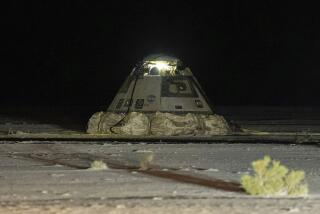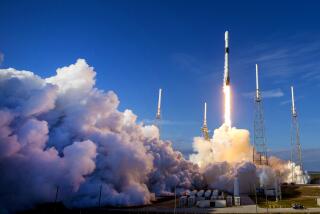Tracking a Tragedy
- Share via
The mounting evidence amassed by the commission on the space shuttle accident leads to the inescapable conclusion that the National Aeronautics and Space Administration made a grievous error in deciding to launch the Challenger on Jan. 28 in the face of warnings from contractors that cold weather made the launching unsafe. The space agency, under enormous pressure to maintain the shuttle schedule and establish a record of reliability, abandoned its normally conservative, safety-first approach and pressed ahead. The resulting explosion destroyed the Challenger and its seven-member crew as well as NASA’s reputation for infallibility.
The investigating commission, under the deft chairmanship of William P. Rogers, has done a superb job of pursuing the facts and questioning those involved in the decision to launch. Engineers and officials of Morton Thiokol Inc., makers of the solid-fuel booster rockets that have been implicated in the disaster, have provided riveting testimony about their conversations with NASA concerning the effect of the cold weather on the seals that hold the sections of the rockets together. On Thursday, Rockwell International, the shuttle’s prime contractor, said that it, too, had advised the space agency that it could not guarantee that the shuttle was safe to fly. NASA’s response to these accounts is unpersuasive.
Whether the principal cause of the accident was an error in engineering or in decision-making, or some combination of the two, remains to be decided. The space agency had ample warning that the design of the booster rockets may have been flawed, but it decided that the hazard was sufficiently small that no corrective action was needed. It ignored an Air Force report that estimated the chances of a catastrophic accident at 1 in 35--dangerously short odds, considering that it had already launched the shuttles 24 times.
The questions that the commission now must ask are those that go something like these: Did the space agency, buoyed by its unbroken record of success, make the mistake of believing its press clippings and allowing its can-do attitude to mask the real dangers that each shuttle faced on launch? Are the O rings on the booster rockets an aberration, or are they an indication that NASA has let other safety factors slip in its all-out effort to keep the shuttles flying?
To be sure, the space agency, which during the Apollo program got all the money that it asked for from Congress, has had to make do since then with less money than it thought it needed. The pressures on the agency came from its budget as well as from its shuttle schedule. But it was incumbent on officials to maintain the highest safety standards that they could despite all that. It was their duty to continue to postpone launchings, regardless of how embarrassing that might be, until they were sure that both the basic machine and the conditions of launch were right.
Besides the engineering factors involved, the Rogers commission must satisfy itself that it knows what went wrong with the human factors. The tragedy of Challenger is that it appears that the accident could have been prevented had decision-makers paid attention and not been lulled into a false sense of complacency. How the same chain of thinking can be prevented in the future is a vital question both for the space program and for all high-technology endeavors that have the potential both for great benefit and for great harm.
More to Read
Inside the business of entertainment
The Wide Shot brings you news, analysis and insights on everything from streaming wars to production — and what it all means for the future.
You may occasionally receive promotional content from the Los Angeles Times.










